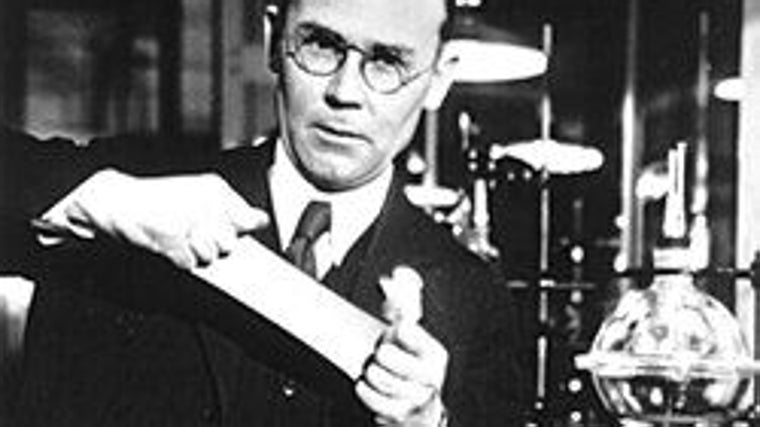Nylon, the synthetic fiber that was created to make parachutes in World War II

Let's imagine for a moment a time when science was almost a wilderness, where laboratories were more like magicians' workshops than research centers. We're in the 1930s in the United States. There, a chemical company (DuPont) decided to take a big gamble: creating a synthetic fiber to replace silk, that luxurious oriental thread that dresses women and decorates homes, but whose import is endangered due to political tensions with Japan.
In this novelistic way begins the story of nylon, the first synthetic polymer that forever changed fashion, industry, and, in some ways, our daily lives.
In 1928, DuPont recruited a brilliant and somewhat troubled young chemist named Wallace Hume Carothers to head the company's organic chemistry laboratory. His initial mission was not to invent the next great textile fiber, but rather to explore the mysterious world of "giant molecules"—polymers—which were just beginning to be understood.
The truth is that on paper the idea was quite simple: to manufacture a molecule so large and complex that it would break all records of the time. The practical objective? None in particular. It was pure basic science, a bet that "something useful" would emerge from this uncharted territory.
Carothers' laboratory was a hotbed of ideas, test tubes, and exotic reagents. There, a team of young scientists, including Julian Hill and Gerard Berchet, experimented with all kinds of reactions, mixing acids, alcohols, and amines in search of new molecular structures.
In 1930, after months of testing, Hill managed to create a "superpolyester" with a molecular weight of over 12,000. It was an interesting material, but too brittle and water-soluble for practical applications. However, the discovery lit a spark: if we've come this far, we can keep moving forward.
 Chemist Wallace Carothers
Wikipedia
Chemist Wallace Carothers
Wikipedia
At the same time, DuPont's management, concerned about geopolitical instability, issued a clear order: "We want a fiber to replace silk!" Silk was essential not only for fashion but also for military applications such as parachutes. The challenge was enormous: to match the strength, elasticity, and luster of natural silk, but manufactured in a laboratory.
Carothers and his team then focused on polyamides, a family of polymers that, theoretically, could form long, strong fibers. After hundreds of experiments, on February 28, 1935, Gerard Berchet produced for the first time a small quantity of a polymer formed by the reaction of hexamethylenediamine and adipic acid: polyamide 6-6, the future nylon.
The discovery was accidental. The team was testing different combinations of monomers when, upon removing a glass rod from the molten mixture, they observed that a long, strong, and flexible filament was formed. "It looks like silk!" exclaimed one of the researchers. No one could believe it: they had created a synthetic fiber that, when cooled, maintained its shape and strength.
The material was so strong that, according to legend, scientists had fun testing its strength, stretching the filaments to their limits. Nylon was born, although it still had no name or commercial application.
Despite the enthusiasm in the laboratory, the path to industrial production was not easy. Nylon had a high melting point and was difficult to handle, but the promise of a synthetic fiber was too tempting to pass up. DuPont invested millions in perfecting the process and, in 1938, officially patented nylon.
The first major test came in 1939, during the New York World's Fair, where the first nylon stockings were presented. The success was immediate and overwhelming: women lined up endlessly to get their hands on them, and before long, nylon became synonymous with modernity and progress.
Nylon not only revolutionized the textile industry. Its strength and versatility allowed it to be used in toothbrushes, ropes, parachutes, automotive parts, and even medical applications. During World War II, it was vital for making parachutes, ropes, and other military supplies, replacing scarce Japanese silk.
But nylon's true legacy went beyond its applications. Its invention marked the beginning of the era of synthetic polymers, paving the way for materials such as polyester, acrylic, and spandex. Polymer chemistry, a virtually unknown branch until then, became one of the most dynamic and productive disciplines of the 20th century.
Behind this chance and revolutionary discovery was Wallace Carothers, a brilliant man haunted by depression. Despite his achievements, Carothers never saw the commercial success of nylon. In 1937, following the death of his sister and plunged into deep sadness, he committed suicide in a hotel, leaving behind a scientific legacy that would change the world.
To conclude, we are left with a quote from Carothers that perfectly sums up his life philosophy: "Science is the art of the possible, and sometimes, the possible is much more surprising than we imagine."
ABC.es





